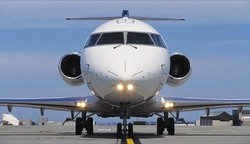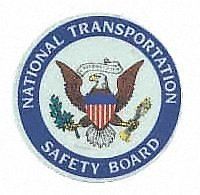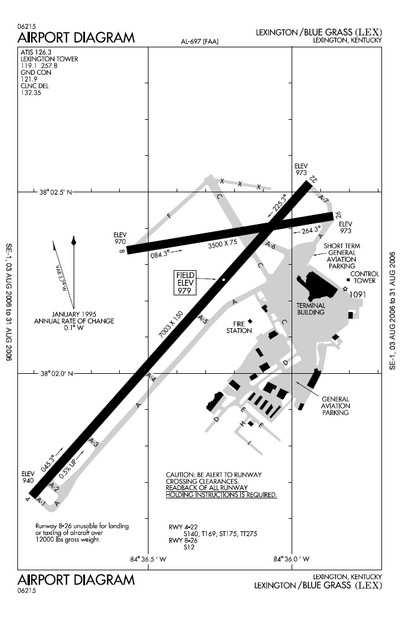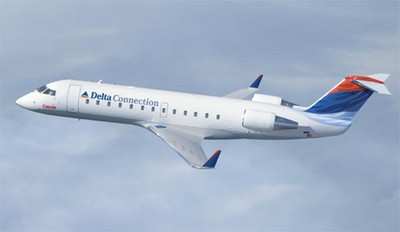One Survivor Reported Among 50 Persons Onboard
 ANN REALTIME Update
08.27.06 1830 EDT: At a press conference from Blue
Grass Airport in Lexington, KY, a spokesperson with the National
Transportation Safety Board confirms the CRJ-100 involved in
Sunday's accident was lined up on a heading of 260 when the plane
crashed immediately after takeoff.
ANN REALTIME Update
08.27.06 1830 EDT: At a press conference from Blue
Grass Airport in Lexington, KY, a spokesperson with the National
Transportation Safety Board confirms the CRJ-100 involved in
Sunday's accident was lined up on a heading of 260 when the plane
crashed immediately after takeoff.
At least one news service also reports that sources have
confirmed the pilot of Comair Flight 5191 took off at 6
am this morning from 3,500-foot runway 26, instead of the
much-longer runway 22 typically used for commercial operations
at that airport. Long before official word of that possibility was
reported, Aero-News received word from several alert News-Spies the
plane had departed from the shorter runway.
Citing evidence from the plane's two flight data recorders --
recovered from the wreckage of the plane -- NTSB spokeswoman Debbie
Hersman added communications between pilots on the aircraft and air
traffic controllers made reference to runway 22, but she refused to
speculate if the plane had been cleared to takeoff on that
runway... or if the plane had actually departed from runway 26.
MSNBC reports one controller was on duty in the KLEX tower
at the time of the accident.
Both Runway 22 and 26 are accessed by Taxiway Alpha at the
airport, with the turnoff for 26 coming before the threshold of the
longer runway. In addition to being less than half the length of
runway 22, the shorter runway is also half as wide -- 75 feet, as
opposed to 150 feet. Runway 26 is also unlit.
It is not yet clear if the plane was able to become airborne
before it crashed, although Hersman did say the plane impacted
a perimeter fence off the end of the runway.
While runway 26 is 2,000-feet shorter than the recommended
runway length for a CRJ-100 at MTOW, it is possible the aircraft
was able to liftoff, but later stalled or experienced another
problem that led to the crash.
 ANN
REALTIME Update 08.27.06 1315 EDT: At an press
conference held earlier today from Blue Grass Airport, an
official stated the wreckage of a 50-seat Comair CRJ-100 that
crashed immediately after takeoff from the Lexington, KY airport
earlier this morning is located just off the end of runway 8 --
fueling speculation the aircraft may have attempted to
take off from the shorter of two runways available at the
field.
ANN
REALTIME Update 08.27.06 1315 EDT: At an press
conference held earlier today from Blue Grass Airport, an
official stated the wreckage of a 50-seat Comair CRJ-100 that
crashed immediately after takeoff from the Lexington, KY airport
earlier this morning is located just off the end of runway 8 --
fueling speculation the aircraft may have attempted to
take off from the shorter of two runways available at the
field.
Reporters at WKYT also confirm the wreckage is off the
approach end to runway 8 -- on the extended centerline of
reciprocal Runway 26. As reported earlier by ANN, Runway 26
is 3,500 feet in length, and is primarily used by general
aviation aircraft.
Commercial traffic at the airport typically uses the longer
7,003-foot Runway 4/22. It is important to note
officials say they still cannot confirm which runway the
aircraft took off from.
According to Bombardier's own specifications for a CRJ-100, FAR
take-off field length at sea level at maximum
takeoff weight is 5,800 feet. At 47 passengers and three
crewmembers, the aircraft was near its maximum passenger load;
officials at the airport also stated regional flights heading
to Atlanta typically takeoff from the airport with full fuel.
One glimmer of positive news from the scene of this tragedy --
as Blue Grass Airport officials report one survivor in the
accident, believed to be first officer James Polehinke. The man is
listed in critical condition.
Sadly, rescue operations have been called off at the scene... as
the focus turns to recovering the bodies of those lost onboard the
plane.
 ANN REALTIME Update, 1040 EST,
082706: The NTSB has dispatched a "GO" Team to
Lexington, Kentucky to investigate this morning's crash of a Comair
regional jet carrying approximately 50 persons.
ANN REALTIME Update, 1040 EST,
082706: The NTSB has dispatched a "GO" Team to
Lexington, Kentucky to investigate this morning's crash of a Comair
regional jet carrying approximately 50 persons.
NTSB senior aviation investigator Joseph Sedor will serve as
Investigator-in-Charge of this investigation. The team of
about a dozen investigators will be accompanied by NTSB Member
Debbie Hersman, who will serve as principal spokesperson while on
scene. A team of NTSB officials from its Office of Transportation
Disaster Assistance will set up a family assistance center in the
Lexington area later today.
ANN REALTIME Update, 1019 EST, 082706: The
previously reported survivor has been identified in some local
media reports as the aircraft's First Officer. The aircraft was
purchased in January of 2001 and received some form of 'routine
scheduled' maintenance on Saturday, according to Comair
officials. The Lexington Bluegrass Airport resumed operations
at approximately 0900.
ANN REALTIME Update, 0913 EST, 082706: ANN has
received a number of UNCONFIRMED reports from local pilots, and
echoed by discussions with local media, that the Comair CRJ
MAY have used a much shorter runway than intended. If Comair Flight
5191 used Runway 26 instead of 22, they used a departure
runway with only 3500 feet available, instead of the 7003'
available on Runway 22.
ANN REALTIME Update, 0910 EST, 082706: ANN
readers near the Bluegrass Airport report that one ambulance has
taken a victim from the crash site to a local hospital, but no
other possibility of any survivors have been reported. The survivor
is being described has having been transported in critical
condition and is described as a male. The aircraft involved was
Comair Flight 5191, a CRJ-100 regional jet with 47 passengers and
three crew members onboard.

Details remain sketchy at this point, but a Comair
commuter CRJ, serving Delta Airlines, went down on takeoff at 0607
EST, from the Bluegrass Airport in Lexington, KY.

Weather appears to not be a factor at this time as the field was
VFR reporting 6 mile viz in haze with a 5500' ceiling. The aircraft
was engaged in a takeoff operation when it went down.
The aircraft went own about a mile from the airport and in a
wooded area. The flight was enroute to Atlanta.
The aircraft is only described at this time as a 50 seat
commuter but visuals suggest that the aircraft is a Bombardier CRJ
(similar to the file photo below). Officials at the scene have
confirmed that there are fatalities (as many as 50 according to one
source) and have yet to report any survivors.

Conditions at KLEX At (Approximate) Time Of
Accident
Temperature: 23.3°C
(74°F)
Dewpoint: 20.0°C (68°F) [RH = 82%]
Pressure (altimeter): 30.04 inches Hg (1017.4
mb)
[Sea-level pressure: 1016.1 mb]
Winds: from the SW (220 degrees) at 7 MPH (6
knots; 3.1 m/s)
Visibility: 6 miles (10 km)
Ceiling: 5500 feet AGL
Clouds: overcast cloud deck at 5500 feet AGL
Weather: HZ (haze)

|
CRJ Specifications
|
| Airframe |
CRJ-100
|
CRJ-200LR
|
| Max Cruise Speed |
459 ktas
|
459 ktas
|
| TOFL (@MGTOW) |
5250 ft.
|
6180 ft.
|
| Power Plant |
CF-34-3A1
|
CF-34-3B1
|
| MGTOW |
47,450 lbs.
|
53,000 lbs.
|
| Max Payload |
12,800 lbs.
|
13,878 lbs.
|
| Range (w/30 Pax) |
980 nm
|
2005 nm
|
| # of Passengers/FlightCrew |
50/2
|
50/2
|
This is the worst US Air Carrier fatality since the loss of
American Airlines Flight 587, which went down Nov. 12, 2001, in
Queens, N.Y., with the loss of 265 people, including five on the
ground. A little over a year later, a Beech 1900 went down
following departure on Jan. 8, 2003, flying under Air Midwest
livery, at the Charlotte/Douglas International Airport -- all 21
aboard were killed.
More recently, a 1947 Grumman G-73 flying for Chalk's Ocean
Airways also went down on December 19th, 2005, shortly after
takeoff from Miami Beach when a catastrophic wing separation
brought the aircraft down, killing 18 passengers and the two
flightcrew. That plane had undergone extensive modification in
1979.
The most recent accident involving a CRJ occured on November 21,
2004, as a China Eastern-Yunnan Airlines Bombardier CRJ-200
impacted shortly after departure. The accident claimed the lives of
47 passengers and 6 crew members, as well as two persons on the
ground. That accident has resulted in litigation claiming problems
with the powerplants.
 According to Comair
documentation, the carrier is a wholly owned subsidiary of
Delta Air Lines and is based in Cincinnati, Ohio. Comair
"had a major impact on commercial aviation when it introduced
regionals jets to North America in 1993. Comair's introduction of
regional jets and its rapid growth helped lead to expanded air
service for communities across the nation. The company became the
first regional airline to operate an all-jet fleet." Founded in
1977, Comair currently operates 168 CRJs and employs more than
6,000 aviation professionals and flies to cities in the United
States, Canada and the Bahamas.
According to Comair
documentation, the carrier is a wholly owned subsidiary of
Delta Air Lines and is based in Cincinnati, Ohio. Comair
"had a major impact on commercial aviation when it introduced
regionals jets to North America in 1993. Comair's introduction of
regional jets and its rapid growth helped lead to expanded air
service for communities across the nation. The company became the
first regional airline to operate an all-jet fleet." Founded in
1977, Comair currently operates 168 CRJs and employs more than
6,000 aviation professionals and flies to cities in the United
States, Canada and the Bahamas.
ANN will update this story as details become available.
 NTSB Final Report: Cozy Cub
NTSB Final Report: Cozy Cub ANN FAQ: Contributing To Aero-TV
ANN FAQ: Contributing To Aero-TV Classic Aero-TV: Seated On The Edge Of Forever -- A PPC's Bird's Eye View
Classic Aero-TV: Seated On The Edge Of Forever -- A PPC's Bird's Eye View ANN's Daily Aero-Linx (04.29.25)
ANN's Daily Aero-Linx (04.29.25) ANN's Daily Aero-Term (04.29.25): Execute Missed Approach
ANN's Daily Aero-Term (04.29.25): Execute Missed Approach









